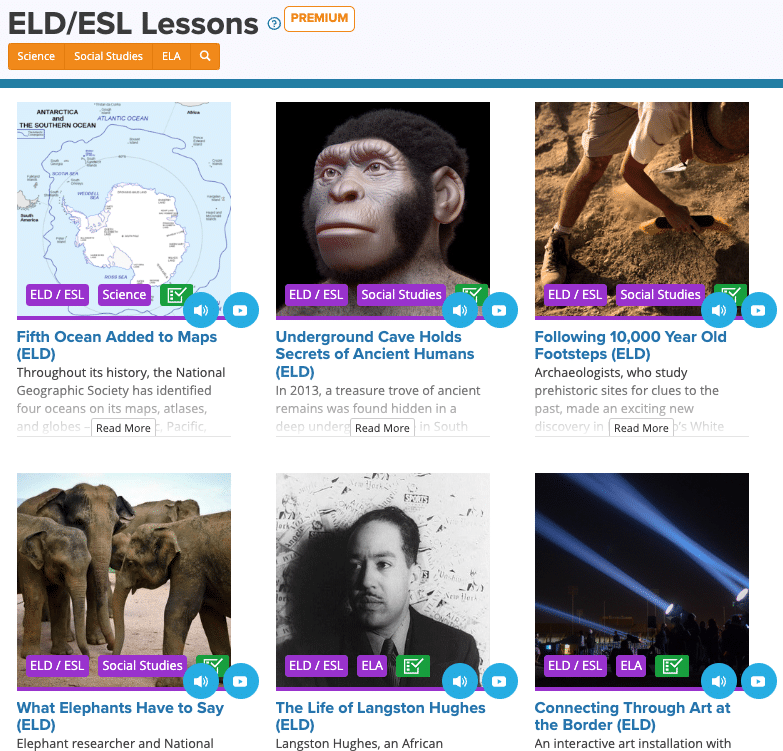Last Updated on October 6, 2025
Listenwise hosted a webinar with California teacher and newcomer advocate Efraín M. Tovar on the subject of using our platform with newcomer English learners. The conversation covered various topics such as the benefits of using Listenwise for newcomers, how to select and customize lessons, and how to provide adequate support for newcomer student learning while maintaining academic rigor.
We are excited to share four steps for using Listenwise’s ELD podcast and video lessons with newcomers using strategies discussed during the webinar “Boosting Achievement with Newcomers Using Listenwise.”
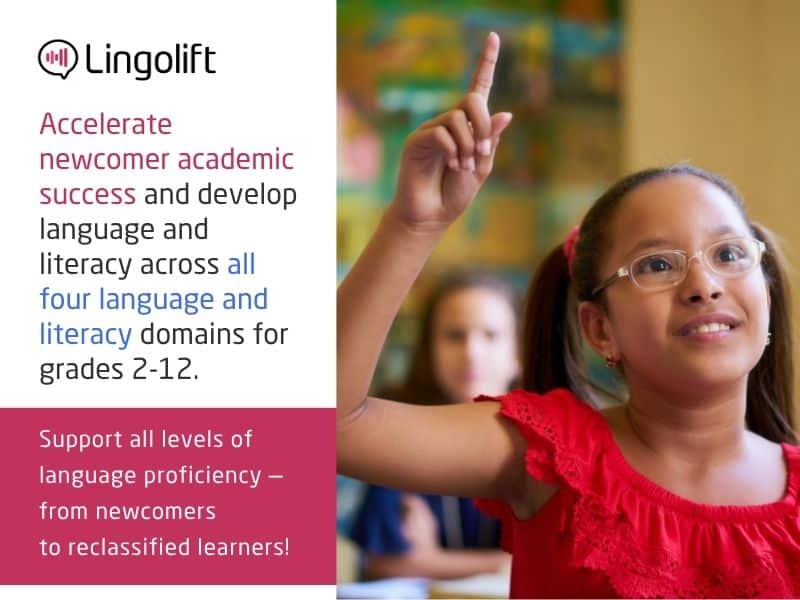
As of August 2024, Listenwise has a new product designed for newcomers and emergent multilinguals in grades 2-12. Lingolift helps students develop English language proficiency across all four language domains: listening, speaking, reading, and writing.
4 Steps to Using Listenwise With Newcomer English Learners
Step 1: Find the Right Story for Newcomer English Learners
Step 2: Preview Vocabulary & Build Background with Imagery
Step 3: Diagram Paragraphs Using Transcripts
Step 4: Check for Understanding with Comprehension and Discussion
Step 1: Find the Right Story for Newcomer English Learners
One of the primary benefits of using Listenwise with newcomer English learners is that it provides students with an opportunity to learn language and content together. Our platform has a vast library of podcast and video lessons on a wide variety of subjects that are suitable for use with students at different stages of English language acquisition.
Efraín recommends providing opportunities for students to choose which podcast topics they’d like to listen to whenever possible. He appreciates that these podcasts offer students the experience of listening to authentic language in context, rather than robotic, automated text-to-speech audio.
- Setting Realistic Expectations: Efraín chose a longer podcast about Jane Goodall for his students. He stresses the importance of understanding that language acquisition takes time. “It’s going to take more time to go through a [longer] story… it might take [newcomers] a week to understand.” It’s better to go a “foot deep” into learning than just an “inch deep.”
- Shorter Options: If you think your newcomer English learners could benefit from listening to shorter podcasts, explore our library. Most of our lessons are under three minutes long. Our 30-second Weird News stories are excellent, concise options that teach language through engaging, funny, and surprising content.
Step 2: Preview Vocabulary & Build Background with Imagery
When working through a Listenwise ELD podcast and video lesson with newcomer English learners, the first step is to build background knowledge by previewing vocabulary. Efraín recommends using the images provided by Listenwise in the assignment as a way of introducing those key vocabulary words students will need to know in order to understand the lesson.
“I love the fact that Listenwise provides at least three images with each lesson so that you can use them [to build background knowledge].”
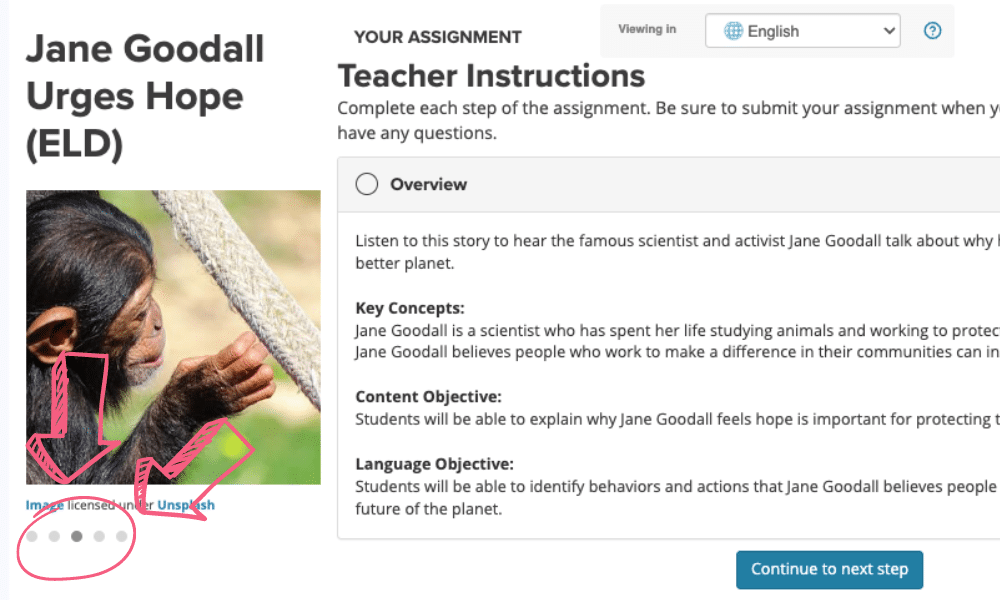
Using Images to Spark Discussion
- Introduce the Image: Start with a standalone image and guide students through a discussion about what they see. Ask open-ended questions like: What do you notice? What do you wonder?
- Encourage Native Language Use: Students should be encouraged to write their initial thoughts in their native language or work with a language broker/partner for assistance.
- Introduce Vocabulary: Next, provide the image along with the specific key vocabulary you want them to learn. Use sentence stems for speaking practice, such as: “I believe that the image shows…”.


Transition to Content: Only after students have become familiar with the key vocabulary words should teachers move on to the listening portion of the lesson.
Step 3: Diagram Paragraphs Using Transcripts
Podcast transcripts are an invaluable tool for teachers looking to support the listening comprehension skills of newcomer English learners. Efraín recommends that teachers lead students through the podcast transcript paragraph by paragraph before they even listen to the audio.Every Listenwise ELD podcast and video lesson includes a podcast transcript in both English and Spanish. Teachers can easily take the transcript and break it down into manageable chunks to scaffold comprehension.
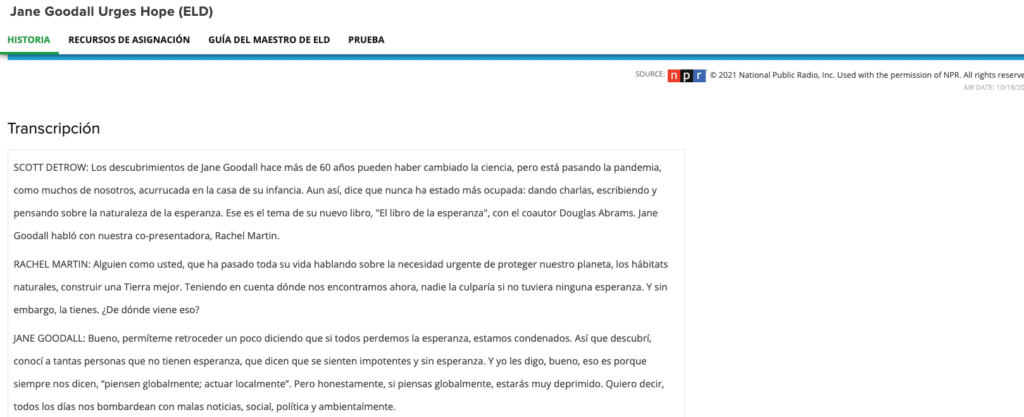
The Power of Diagramming
- Focus and Intentionality: Depending on the length of the podcast, this pre-listening step may take a few days or even a few weeks, which is perfectly fine. This intentional approach allows sufficient time for deep vocabulary development.
- Vocabulary in Context: Diagramming each paragraph allows newcomer English learners time to focus on individual new vocabulary words and see exactly how they contribute to the overall meaning of the paragraph.
Take a look at this example of a presentation slide Efraín Tovar uses to help introduce his newcomer students to key vocabulary terms found in the podcast transcript. The green boxes indicate areas he completes with his students.
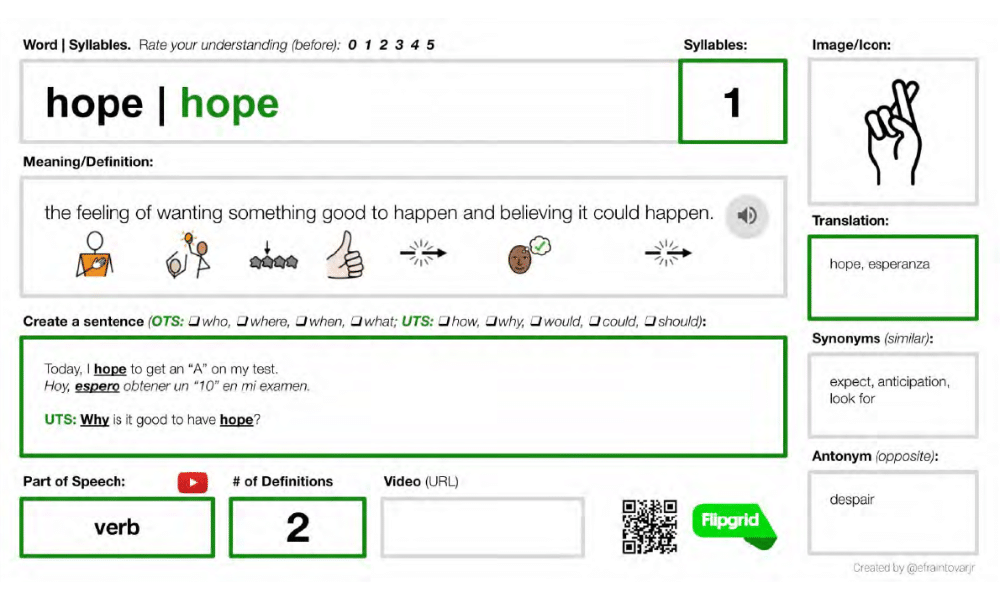
Listenwise further supports this process by providing lists of key vocabulary words and Spanish-language cognates for each ELD lesson. Our interactive vocabulary flashcards allow students to review vocabulary independently prior to listening.
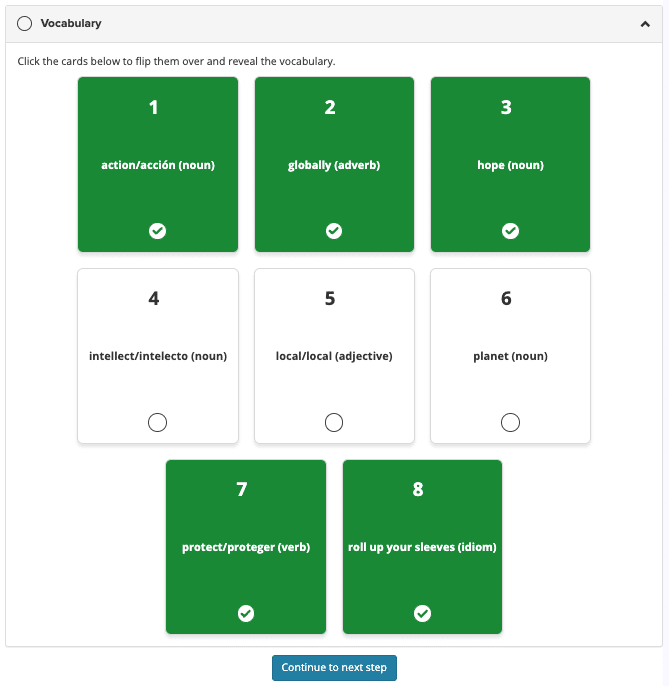
Visual Supports
- Word Clouds: Another excellent tip for introducing vocabulary to newcomer English learners is to “app smash” Listenwise with a word cloud generator like WordClouds. This connects commonly used vocabulary from the transcript to a visual representation, such as a chimp (for the Jane Goodall example).
- Picture Dictionary: Listenwise provides visual support directly in the transcript using our picture dictionary. Students can click an unfamiliar word and select the picture dictionary icon to see a simple illustration of the word’s definition, providing crucial context as they listen and read along.
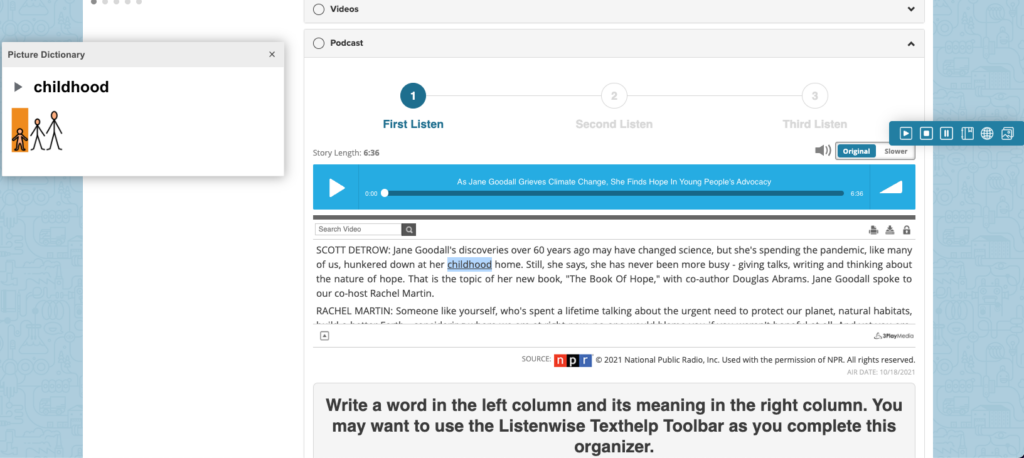
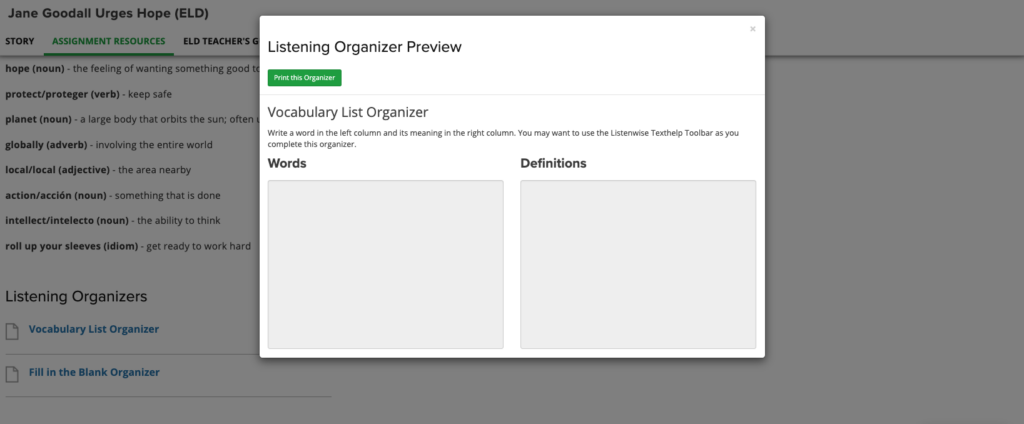
Step 4: Check for Understanding with Comprehension and Discussion
After working through the paragraphs and vocabulary, provide multiple listening opportunities with our embedded three close listens functionality. Remind newcomer English learners they also have the ability to play the audio at a slower speed.
Once students have listened to the content, it’s time to check for understanding using multiple strategies that assess all four language domains.
- Assessment Tools: Listenwise provides pre-made listening organizers that can be used as assessment tools. Our lessons also include customizable comprehension questions that can help teachers pinpoint which specific sections of the audio story might be challenging.
- Promoting Speaking: The platform provides students with an opportunity to practice their speaking and writing skills by responding to prompts and questions. Efraín noted a statistic shared at the 2023 CABE conference that English learners spend just 12% of their day speaking their target language.
It’s really important that we get our newcomers to speak — that we get them to use language. How do we learn language? We need opportunities to use it in the classroom.
Watch this brief clip from a webinar featuring educator and multilingual thought-leader Valentina Gonzalez. She models encouraging classroom discussion using a Listenwise Weird News podcast lesson, “The Ketchup Thief.” With appropriate scaffolds and supports, this exercise can be adapted for your newcomer English learners.
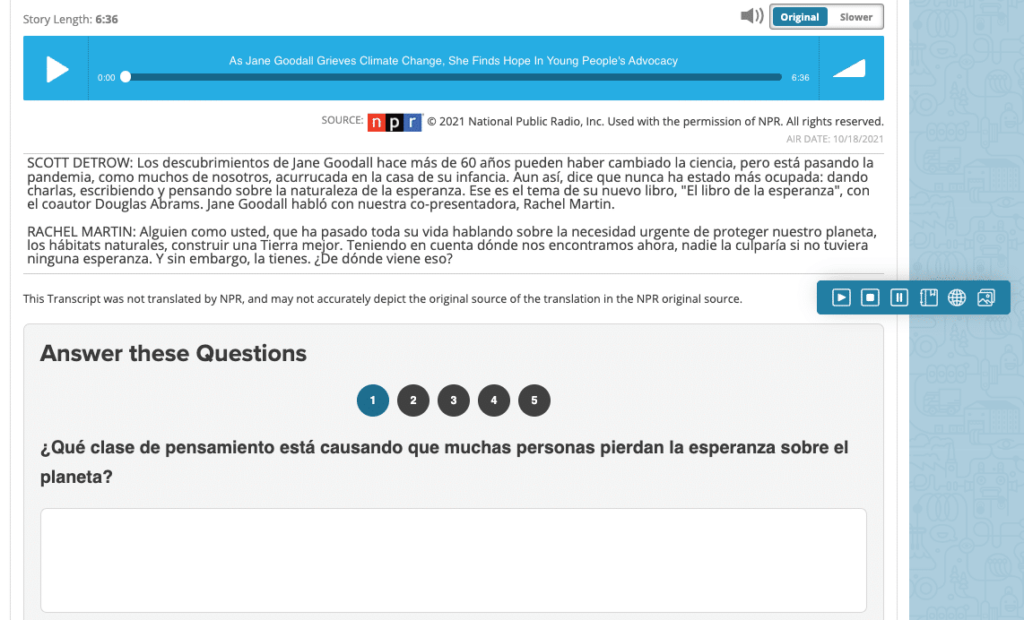
Additionally, the platform provides students with an opportunity to practice their speaking and writing skills by responding to prompts and questions related to the audio content. Efraín mentions in this webinar that a recent statistic shared at the 2023 California Association of Bilingual Educators (CABE) conference states that English learners spend just 12% of their day speaking their target language.
“It’s really important that we get our newcomers to speak — that we get them to use language. How do we learn language? We need opportunities to use it in the classroom, and we have to have opportunities to speak in the classroom.”
Our blog post on building speaking and listening skills for English learners offers additional ideas.
Watch this brief clip from a webinar featuring educator and multilingual thought-leader Valentina Gonzalez to see her model how she would go about encouraging classroom discussion using a Listenwise Weird News podcast lesson, “The Ketchup Thief.” Using the appropriate scaffolds and supports, this exercise can be adapted for use with newcomer students.
We hope that this blog post has given you some practical tips for how to adapt Listenwise content for use with newcomer English learners. As we continue to grow and expand our platform, it is our hope that we can deliver even more curriculum-aligned, meaningful content to support English learners at every stage of language acquisition.

